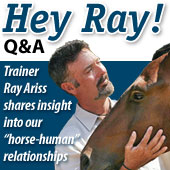 HEY RAY!: My wife just purchased a third-level dressage mare in foal that is due this spring, and we want to show her in the fall. When can we start training the mare and when should we wean the foal?
HEY RAY!: My wife just purchased a third-level dressage mare in foal that is due this spring, and we want to show her in the fall. When can we start training the mare and when should we wean the foal?
— Brenden Johnson, Eureka Springs, Ark.
HEY BRENDEN: Congratulations on your new addition! The first question that comes to mind is whether or not your mare has been ridden through the pregnancy. If she hasn’t, I suggest you do nothing until after the baby is born. If she has been ridden and your goal is to show her this year, continue to ride carefully and considerately right up until she gets ready to foal, providing she feels up to it.
Like some people, some mares maintain physically active with no complications whatsoever. The key here is not to start anything new — that is when problems surface. Also, keep in mind that the more active you keep your mare, the better for the baby, mare and your showing goals.
There are mares that carry their babies so well that they barely slow down in their progress through training. On the other hand, some mares will become so big and heavy that they become incapable of keeping up a pace safely. This is where your judgment comes in, and remember: When in doubt, slow down or stop.
Obviously, working side-by-side with a veterinarian during the pregnancy is ideal. Being able to bounce questions about your goals with your vet will help you make sound, smart decisions about the strategy toward your goal. Long, slow, warm-ups, as well as cool-downs, are a must — especially with mares in this type of condition.
Before the baby is born, consider having a dividing panel with a gate in your foaling stall or pen in order to facilitate separation of mom and baby during certain times of the day. There are a couple of reasons why this will be important and helpful. First, it will aid in being able to check mare and baby separately if necessary. Second, it will allow the mare to get a break from time to time when needed without stressing either mare or foal because they will be right next door, able to see each other. It also will help with medicating as well as supplementing each one individually, if needed. And finally, it will begin the weaning process in a considerate and stress-free manner for the future.
Taking the mare out for light lunging after foaling will not only allow the mare to focus more easily on work, but will allow her and the baby to deal with the stress of being apart for small periods of time. I suggest separating mare and foal for these types of exercises only after they have had a chance to bond. It is important that you give the baby the opportunity to learn to follow her mom when loose in case the baby gets out by accident. Allowing mare and foal to run and play while turned out in the arena will give ample opportunity for this to happen. Obviously, this instinct would be more important in a pasture or wild environment than in the stable environment that she will be in, but important nonetheless. The later you wait to wean the foal, the better. This does not mean that you cannot wean them sooner, especially if the foal becomes a drain on the mare. Usually four to six months before weaning is customary, but three months can be acceptable, especially if the foal has grown to a mature size and is eating well.
In your case, you will definitely have to focus equally on your mare and foal’s appearance more than usual. It is more common than not to see big babies and thin mares during the nursing/suckling stage. So keep a close eye in order to keep a nice and healthy outline on your future show partner.
Being able to work your mare a week or two after foaling carefully and gradually while the baby is in the arena/pen is a good idea. This will give you a chance to condition your mare mentally and physically towards your program.
Once your mare begins to focus more on riding and less on mothering, you can begin to consider training more without the baby. Brenden, the experience that you are about to embark is one that will be exciting and memorable at so many levels. If you run short on time in preparing your mare for her next show, keep your priorities straight. You will only get one chance to prepare this important foundation for your mare and foal, but plenty of opportunities to exhibit the finished product.
As always and above all, trust your instincts and think safe,
Ray
Horsetrader columnist Ray Ariss, husband to Pippa Ariss and father of six, shares his insight into the relationship of horse-and-human twice each month, in print and on www.horsetrader.com. He lives and trains in “Horsetown USA”, Norco CA, at his bustling StarBrite Riding Academy. Does your “horse-human” relationship leave you with a question for Ray? Just go to www.horsetrader.com and click on the “Hey Ray!” section, then submit it!
Leave a Comment
All fields must be filled in to leave a message.